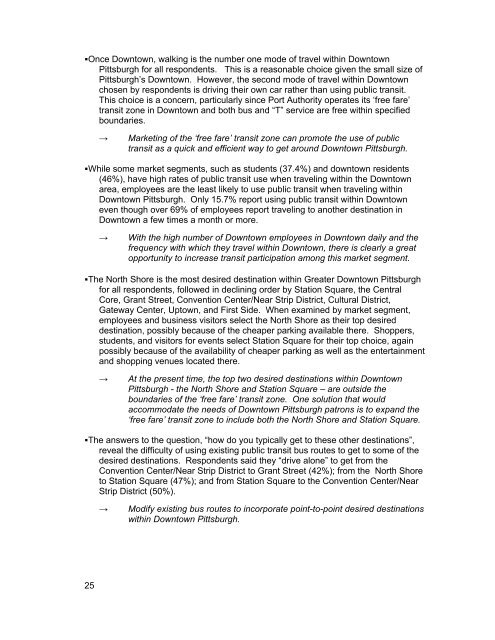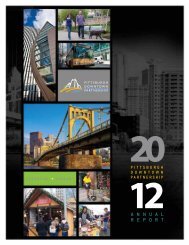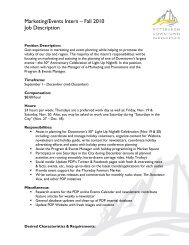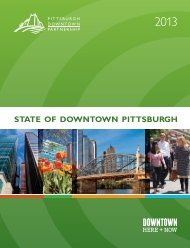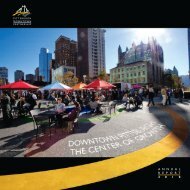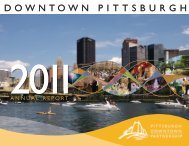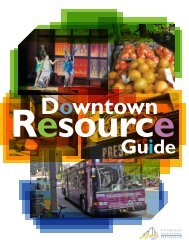Executive Report - The Pittsburgh Downtown Partnership
Executive Report - The Pittsburgh Downtown Partnership
Executive Report - The Pittsburgh Downtown Partnership
Create successful ePaper yourself
Turn your PDF publications into a flip-book with our unique Google optimized e-Paper software.
•Once <strong>Downtown</strong>, walking is the number one mode of travel within <strong>Downtown</strong><strong>Pittsburgh</strong> for all respondents. This is a reasonable choice given the small size of<strong>Pittsburgh</strong>’s <strong>Downtown</strong>. However, the second mode of travel within <strong>Downtown</strong>chosen by respondents is driving their own car rather than using public transit.This choice is a concern, particularly since Port Authority operates its ‘free fare’transit zone in <strong>Downtown</strong> and both bus and “T” service are free within specifiedboundaries.→Marketing of the ‘free fare’ transit zone can promote the use of publictransit as a quick and efficient way to get around <strong>Downtown</strong> <strong>Pittsburgh</strong>.•While some market segments, such as students (37.4%) and downtown residents(46%), have high rates of public transit use when traveling within the <strong>Downtown</strong>area, employees are the least likely to use public transit when traveling within<strong>Downtown</strong> <strong>Pittsburgh</strong>. Only 15.7% report using public transit within <strong>Downtown</strong>even though over 69% of employees report traveling to another destination in<strong>Downtown</strong> a few times a month or more.→With the high number of <strong>Downtown</strong> employees in <strong>Downtown</strong> daily and thefrequency with which they travel within <strong>Downtown</strong>, there is clearly a greatopportunity to increase transit participation among this market segment.•<strong>The</strong> North Shore is the most desired destination within Greater <strong>Downtown</strong> <strong>Pittsburgh</strong>for all respondents, followed in declining order by Station Square, the CentralCore, Grant Street, Convention Center/Near Strip District, Cultural District,Gateway Center, Uptown, and First Side. When examined by market segment,employees and business visitors select the North Shore as their top desireddestination, possibly because of the cheaper parking available there. Shoppers,students, and visitors for events select Station Square for their top choice, againpossibly because of the availability of cheaper parking as well as the entertainmentand shopping venues located there.→At the present time, the top two desired destinations within <strong>Downtown</strong><strong>Pittsburgh</strong> - the North Shore and Station Square – are outside theboundaries of the ‘free fare’ transit zone. One solution that wouldaccommodate the needs of <strong>Downtown</strong> <strong>Pittsburgh</strong> patrons is to expand the‘free fare’ transit zone to include both the North Shore and Station Square.•<strong>The</strong> answers to the question, “how do you typically get to these other destinations”,reveal the difficulty of using existing public transit bus routes to get to some of thedesired destinations. Respondents said they “drive alone” to get from theConvention Center/Near Strip District to Grant Street (42%); from the North Shoreto Station Square (47%); and from Station Square to the Convention Center/NearStrip District (50%).→Modify existing bus routes to incorporate point-to-point desired destinationswithin <strong>Downtown</strong> <strong>Pittsburgh</strong>.25


